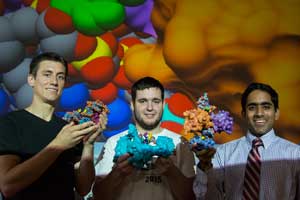STUDENTS | Students present 3D work at International Conference
 Steven Mathews’ first trip on his own outside of Rhode Island gave him the opportunity to meet people who work in outer space.
Steven Mathews’ first trip on his own outside of Rhode Island gave him the opportunity to meet people who work in outer space.
Mathews, a University of Rhode Island doctor of pharmacy student, traveled with Bongsup Cho, professor of biomedical sciences in the College of Pharmacy, to Bates College to present a poster describing three-dimensional modeling and printing as teaching tools in URI’s pharmacy curriculum.
Mathews of South Kingstown and two URI graduate students, Matthew Blake of Coventry and Stephen Norris of North Attleboro, Mass., teamed up to develop the poster presentation for the Gordon Research Conference on Visualization in Science and Education program from Aug. 2 through Aug. 7 in Maine. Blake is pursuing a master’s degree in medicinal chemistry and serves as a teaching assistant in URI’s interdisciplinary laboratory classes. Norris is pursuing a master’s degree in electrical engineering.
Cho said the conference brought together top science visualization specialists from around the world with one goal — making science more understandable through visualization tools.
By the end of the conference, Mathews had rubbed elbows with visualization experts from all over the world, from cancer researchers at Harvard Medical School to a visual effects producer who worked on Cosmos: A Spacetime Odyssey. Mathews’ and Cho’s conversations led NASA representatives at the conference to send the student team a computer model of a large asteroid named Vesta so they could develop a 3D print of the asteroid.
“NASA mapped the entire surface of the asteroid and created a 3D model,” Mathews said. “We asked them for the file, and they were happy to lend it to us.”
While the rocket scientists were interested in what the team could do with a 3D image of an asteroid, the students’ poster highlighted several lab experiences for the doctor of pharmacy curriculum that relate to cancer drugs, antibiotics and the issue of drug resistance. Molecular modeling sessions are conducted each semester for several disease-based “cores.” The group found that the ability to hold and examine a 3D model provides a greater understanding of the direct, but seemingly abstract relationship between structure and drug action.”
“This was my first time on my own outside of Rhode Island,” Mathews said. “Even staying in a dorm, just focusing on my own personal development was a new experience.”
He said he is deeply grateful to the College of Pharmacy and Cho for providing the support necessary to make the trip.
“It was Dr. Cho who suggested to Matt, Stephen and me that we should apply to the conference and develop an abstract for a proposal. He constantly encouraged us to pursue the process of creating materials for submission,” Mathews said.
The College of Pharmacy has been conducting 3D modeling and creating 3D animations of molecular processes since 2004 in collaboration with Roy Bergstrom in Instructional Technology and Media Services, thanks to grants from the Champlin Foundations. Another Champlin grant allowed the college to purchase a 3D printer in 2011 and begin printing molecules. The tools are now staples of instruction in the college.
Mathews had taken pharmacy classes in which 3D modeling and printing were used to augment the lecture.
“As a student in pharmacy, I found the 3D modeling and printing lab forced me to think differently than I had in traditional organic chemistry classes,” Mathews said.
Blake, the medicinal chemistry graduate student, said it could be very difficult to convey structure at the molecular level using one-dimensional lines and drawings.
“3D modeling is very useful in chemistry because the structure of the molecule is going to determine its function,” Blake said. “That’s made easier with 3D tools.”
Mathews said the trio conducted a survey of students to see whether 3D modeling and printing were helping them grasp the material.
“They found that it was a different way to look at a molecule, and that if they didn’t get the concept in the lecture, they got it in here (the 3D modeling and printing lab.)”
Norris, the electrical engineering major, said he heard about the 3D lab through a flier. “My computer engineering experience helped me with this,” he said.
In fact, Mathews and Blake said that without Norris’ computer knowledge, the project would not have progressed as well as it had.
“That’s what makes this team so great,” Blake said. “Everyone brings something different.”
“When I need technical help, I go to Stephen (Norris),” Cho said.
“He is the one who pulls us back from being too technical so our presentations are understandable,” Mathews said of Norris. “The 3D printing lab’s mission is to make the science more accessible, so it’s of utmost importance to make sure everyone’s understanding of the models we print are clear.”
Media Contact: Dave Lavallee, 401-874-5862
Pictured Above
MODELS OF EXCELLENCE: University of Rhode Island graduate students from left, Matthew Blake of Coventry, and Stephen Norris of North Attleboro, Mass., and doctor of pharmacy student Steven Mathews of South Kingstown, display three-dimensional prints of molecules with an enlarged 3D computer model shown on the screen behind them at the College of Pharmacy. They teamed up to develop a poster presentation on using 3D printing and modeling in the classroom for the Gordon Research Conference on Visualization in Science and Education program from Aug. 2 through Aug. 7 in Maine. URI photo by Nora Lewis.
 Home
Home Browse
Browse Close
Close Events
Events Maps
Maps Email
Email Brightspace
Brightspace eCampus
eCampus


